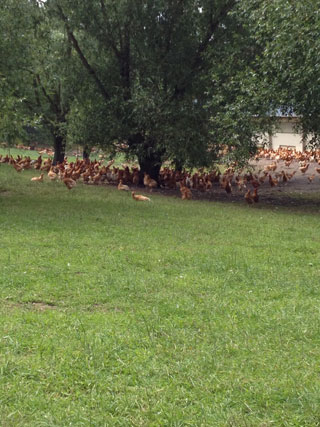Study tour on Quality Labels in France for Serbian meat producers - 1 to 6 June 2014

Raising standards in Serbia's meat sector for a bigger slice of the market
Improving the quality and safety of Serbian meat products is a key ingredient for gaining consumer confidence and cracking a wider market.
With this in mind, FAO Investment Centre and the European Bank for Reconstruction and Development (EBRD), with financing from Luxembourg, organized a study tour to France for a group of Serbian meat producers and processors – small and large enterprises alike – and representatives from relevant associations and the Serbian Ministry of Agriculture and Environmental Protection.
From 1 to 6 June 2014, participants traveled to Paris, the Pays de la Loire and Normandy regions, France, to meet with companies and institutions involved in French meat production and quality certification. The study tour aimed to acquaint participants with examples of public and private quality labels in France – such as the Label rouge – in order to enrich further discussion on the development of a Serbian label to differentiate and market high quality meat products.
This capacity building activity is part of a larger project implemented under the FAO/EBRD cooperation agreement, which seeks to contribute to the development of a more efficient and inclusive meat value chain in Serbia. Participants left more prepared to develop and implement a Serbian quality label, complete with next steps including: assessing local consumer expectations, setting up a platform for a joint public-private partnership, and deciding on the detailed scope of such a label.
Boosting marketability
Serbia's meat industry has excellent potential. More than half of the country's farmers raise livestock, and many produce meat - mainly pork, but also poultry, beef and, to a lesser extent, lamb and mutton.
Though an increasing number of animals are being slaughtered in registered facilities, on-farm slaughtering is still common in Serbia. Only six of the country's 982 slaughterhouses and meat processing facilities are eligible to export to the European Union.
“As Serbia prepares to join the European Union, compliance with rigorous international food quality and safety standards, from animal treatment to slaughterhouse conditions to transport, is key,” said Mr Slobodan Sibalic from the Veterinarian Department.
The country also faces the competition of meat processed from cheap frozen meat in neighbouring countries, for which no trade tariffs are applied. This puts pressure on the Serbian producers of processed meat, which utilize more expensive, fresh raw material.
"Everyone in Serbia - farmers, meat processing plants and the country as a whole - stands to benefit from focusing on quality and making sure that our consumers recognize the freshness and origin of meat products when it can be guaranteed. It will help our meat industry to compete" Ms Snežana Kumbaric from the Ministry’s group for Quality said.
"We all have a role to play from producers, processors, and public authorities.”
For Serbia, that means upgrading public safety standards to align with the EU acquis. This will help allay consumer concerns about health risks. And it means upgrading quality standards, as a way for producers, processors and retailers to set their products apart and give them an edge in the market. For that, having all the meat chain players on board is key.
Sharing knowledge
The study tour delved into the intricacies of quality labels as a step towards addressing the larger issue of meeting quality and safety standards. Over five days, participants met with experts from France's Ministry of Agriculture to discuss such things as developing and managing official labels, policy implications and the advantages of official labels compared with private labels.
They also visited the Institut national de l'origine et de la qualité, a public institution in charge of promoting official origin and quality labels, to learn more about the development of the Label rouge and its specifications in the meat sector. Granted by the French authorities, the label assures consumers that the product in question has met an exacting and verifiable set of quality standards, including those related to organoleptic quality, animal welfare or sustainable production.
Participants weighed the pros and cons of public and private labels and what these labels mean in terms of increased production costs, certification and controls. But also what it takes to develop them it terms of getting organised and working together. They toured an abattoir, production facilities and retail outlets to see what the labels imply at all levels of the chain and how they are marketed on the supermarkets’ shelves.
According to CARNEX representative Ms Tamara Penjic, who works in the meat processing industry, having such a comprehensive overview was mind-opening for Serbia as it moves to enhance the quality and marketability of its meat.
"France has so much experience with food labelling and certification, so it was very interesting to hear from all sides on what works and what doesn't," Mr Goran Ilic, from the food industry’s Yuhor said. "I hope our meat will also gain in quality and recognition, as we have an excellent savoir-faire in Serbia."
